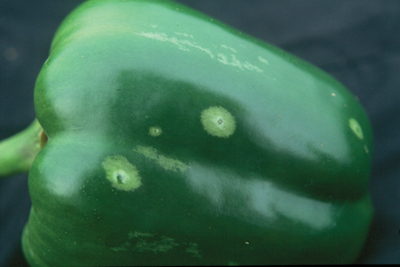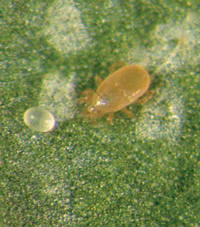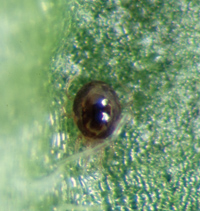
Features
Biocontrols
Inputs
Greenhouse grower notes: February 2010
January 28, 2010 By Gillian Ferguson
Greenhouse pepper growers are very fortunate to have several biological
control agents that are commercially available for management of
western flower thrips that infest greenhouse peppers each year.
Pepper growers are fortunate to have several controls available to control western flower thrips
Greenhouse pepper growers are very fortunate to have several biological control agents that are commercially available for management of western flower thrips that infest greenhouse peppers each year. These biological control agents include several predatory mite species that are released on the plants, among them Amblyseius cucumeris, Amblyseius swirskii, Amblyseius degenerans, and Amblyseius andersoni.
 |
| Pepper fruit with egg-laying spots caused by western flower thrips. PHOTO COURTESY GILLIAN FERGUSON, OMAFRA |
Selection of mite species for optimal year-round suppression of thrips populations can be confusing given all this choice. This article provides some information that may assist in understanding some of the pros of cons of these predators. Information provided is based principally on research led by Yvonne van Houten, currently with Koppert Biological Systems in the Netherlands.
COMPARING A. CUCUMERIS WITH A. SWIRSKII, A. DEGENERANS AND A. ANDERSONI – SUMMER CONDITIONS
Greenhouse trials were carried during a summer when temperatures in the greenhouse were 28-30°C, and as high as 40°C, to evaluate the ability of these four predatory mites to establish, and to suppress populations of western flower thrips under these conditions. Thrips were released for four consecutive weeks in Week 23, 24, 25 and 26. Each of the four predators was released in Week 24 at a rate of 30 females per plant. In addition, a fifth treatment consisted of hanging one sachet of A. cucumeris per plant. Leaves and flowers were sampled for at least eight weeks.
 |
|
| Adult predatory mite Amblyseius cucumeris and recently laid egg. PHOTO COURTESY GILLIAN FERGUSON, OMAFRA |
Results indicated that regarding population establishment, A. degenerans and A. swirskii established more successfully than A. cucumeris and A. andersoni. Of the four predators, A. degenerans was the most successful, being able to increase its numbers rapidly and attain the highest population densities, particularly in the flowers. With respect to suppression of thrips, and based on counts from the flowers, A. swirskii was the most successful in reducing thrips numbers, followed by A. cucumeris released in sachets, A. degenerans, A. andersoni, and A. cucumeris (not in sachets).
COMPARING A. CUCUMERIS WITH A. DEGENERANS – WINTER CONDITIONS
An earlier trial done by van Houten at the Glasshouse Crops Research Station in the Netherlands in greenhouse peppers compared A. cucumeris with A. degenerans during a winter period, and lasted from January to April.
Plants were infested with western flower thrips during the first week of January and predators were released during the fourth week of January (25 females per plant). Flowers and leaves were sampled and data collected for at least 13 weeks.
As in the trial described above, A. degenerans outperformed A. cucumeris by increasing its population more rapidly and reaching higher densities, and also in reducing thrips populations. Although eggs of A. degenerans are more tolerant to lower humidity conditions than those of A. cucumeris, the greater success of A. degenerans in this trial was attributed to its greater searching efficiency and higher activity on the leaves than A. cucumeris. Moreover, A. degenerans was found in much higher numbers in the flowers where it also feeds on pollen.
 |
|
| Adult predatory mite Amblyseius degenerans resting alongside leaf vein. PHOTOS COURTESY GILLIAN FERGUSON, OMAFRA |
Overall, there are pros and cons of each predator. From the trials reported above, it appears that A. degenerans is suitable for year-round application, particularly under low humidity conditions. However, other studies indicate that A. degenerans, being a generalist, will also feed readily on eggs of Aphidoletes, which are often released for biological control of aphids. It may also be more susceptible than A. cucumeris to pesticides such as sulphur.
Regarding A. swirskii, this predatory mite performs very well under summer conditions, but, like A. cucumeris, its eggs are susceptible to low humidity conditions. Amblyseius swirskii is also very aggressive and being a generalist predator, can also prey on other predators such as A. cucumeris, and possibly other predators.
Amblyseius cucumeris itself can also prey on A. swirskii, but at a lower rate. Amblyseius cucumeris released in sachets can provide good suppression but is needed in much higher numbers than A. swirskii. Cage experiments by van Houten showed that even when A. swirskii was released at a rate about 30 times lower than that of A. cucumeris, establishment of A. swirskii still outperformed that of A. cucumeris.
In summary, data presented above suggest that A. swirskii, A. cucumeris, and A. degenerans can each play a role in the management of western flower thrips in greenhouse peppers. Factors such as release rate, economics, environmental conditions, timing of release of a particular species relative to time of year and thrips numbers, all need to be carefully considered to successfully suppress western flower thrips populations in greenhouse peppers. ■
Gillian Ferguson is the greenhouse vegetable IPM specialist with the Ontario Ministry of Agriculture, Food and Rural Affairs in Harrow, Ontario.
• Gillian.Ferguson@Ontario.ca
Print this page